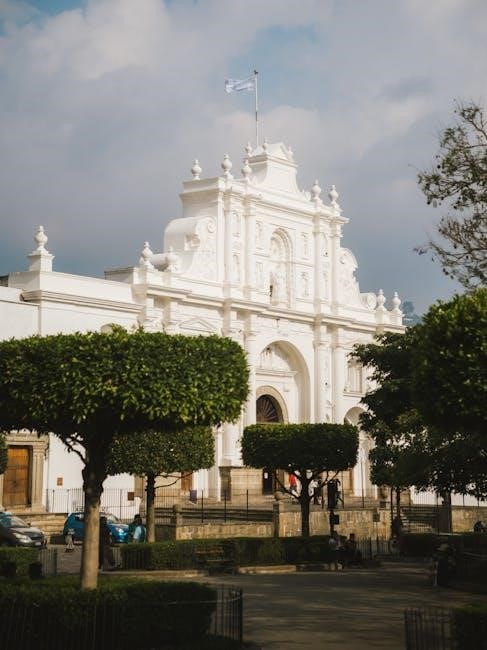The Christian Church’s history is a rich tapestry of faith, transformation, and cultural influence. From its humble beginnings to its global impact, it has shaped civilizations and spirituality profoundly.
Overview of the Christian Church’s Historical Development
The Christian Church’s historical development spans over two millennia, tracing its origins to the life and teachings of Jesus Christ. The early church faced persecution but grew rapidly, influenced by the Roman Empire’s infrastructure and legal frameworks. The Edict of Milan in 313 CE marked a turning point, legitimizing Christianity. The medieval period saw the rise of the papacy, monasticism, and scholasticism, shaping doctrine and practice. The Protestant Reformation in the 16th century challenged Catholic authority, leading to diverse denominations. The modern era brought evangelical movements, missionary efforts, and ecumenical dialogue. Today, the church navigates a global, pluralistic world, addressing contemporary issues while preserving its legacy. This dynamic evolution reflects the church’s adaptability and enduring influence on faith and culture.
Significance of Studying Church History
Studying church history is essential for understanding the development of Christian theology, practices, and institutions. It reveals how the church has navigated cultural, political, and social changes over centuries. By examining key events and figures, such as the apostolic era, the rise of the papacy, and the Reformation, one gains insight into the church’s role in shaping Western civilization. Church history also highlights the preservation of Christian traditions and the evolution of doctrinal thought. Additionally, it provides context for contemporary issues, showing how historical challenges and responses continue to influence modern faith communities. Through this study, believers and scholars alike can appreciate the church’s adaptability and its enduring message amidst a changing world.
Key Sources for Understanding Church History

Understanding the history of the Christian Church relies on diverse sources, including ancient texts, theological writings, and historical records. Works like Dr. Jesse Lyman Hurlbut’s History of the Christian Church provide comprehensive insights, while Robert A. Baker’s Christian History offers a concise overview. Theological texts, such as those by St. Augustine and St. Thomas Aquinas, highlight doctrinal developments. Historical documents from the Roman Empire, like those mentioning early persecutions, shed light on Christianity’s early struggles. Additionally, records from church councils and missionary accounts reveal the global spread of Christianity. These sources collectively offer a vivid understanding of the Church’s evolution, blending faith, culture, and historical context to paint a detailed portrait of its journey through the centuries.

The Early Christian Church
The early Christian Church emerged amidst persecution and Roman influence, spreading rapidly through apostolic missions and enduring trials that shaped its foundational beliefs and practices.
The Life and Teachings of Jesus Christ
Jesus Christ, the central figure of Christianity, lived a life marked by profound teachings and miraculous acts that laid the foundation of the Christian faith. His ministry, spanning approximately three years, emphasized love, compassion, and the kingdom of God. Through parables and direct instruction, Jesus taught about forgiveness, humility, and the importance of caring for others. His miracles, such as healing the sick and feeding the multitude, demonstrated divine authority and reinforced His message. Jesus’ teachings challenged societal norms, advocating for the marginalized and calling people to a deeper spiritual life. His ultimate sacrifice on the cross and resurrection are seen as the fulfillment of God’s plan for humanity, offering salvation and eternal life. These events and teachings have shaped the Christian Church’s doctrine, practices, and global influence, making Jesus the cornerstone of Christian history and belief. His legacy endures as a source of inspiration and transformation.
The Apostolic Age and the Spread of Christianity
The Apostolic Age, immediately following Jesus Christ’s resurrection, marked the birth of Christianity as a global movement. The apostles, led by Peter and Paul, fulfilled the Great Commission, spreading Jesus’ teachings across the Roman Empire. This period saw the establishment of the first Christian communities in Jerusalem and beyond; The apostles’ missionary journeys, facilitated by the Roman Empire’s infrastructure, enabled the rapid dissemination of the Gospel. The Council of Jerusalem, a pivotal event, unified the early church by resolving tensions between Jewish and Gentile believers. This era laid the foundation for Christianity’s expansion, emphasizing faith, sacraments, and communal life. The apostles’ writings and teachings became the cornerstone of Christian doctrine, shaping the church’s identity and mission for centuries to come.

The Persecution of Early Christians
The early Christian Church faced intense persecution, particularly under Roman emperors like Nero, who blamed Christians for the Great Fire of Rome in 64 AD. This marked the beginning of systematic oppression, as Christians were seen as a threat to Roman authority and pagan traditions. Many were martyred, including prominent figures like St. Peter and St. Paul, whose executions became symbols of faith. Despite the brutality, persecution paradoxically strengthened the Church, as martyrs’ testimonies inspired others to embrace Christianity. The Roman Empire’s hostility pushed Christians to organize secretly, fostering resilience and unity. This period of suffering laid the foundation for the Church’s enduring identity and mission, showcasing the transformative power of faith in the face of adversity.
The Role of the Roman Empire in Early Christianity
The Roman Empire played a pivotal role in shaping early Christianity, initially as a persecutor and later as a catalyst for its spread. Emperor Nero’s reign marked the first major persecution of Christians, setting a precedent for sporadic repression under subsequent rulers. However, Emperor Constantine’s Edict of Milan in 313 AD legalized Christianity, transforming the empire’s stance. The Roman infrastructure facilitated the spread of Christian teachings, while its administrative systems influenced the Church’s organizational structure. The adaptation of Roman traditions, such as festivals and hierarchical governance, further integrated Christianity into the empire’s fabric. Despite this, the Church maintained its spiritual identity, often challenging Roman authority. This duality of cooperation and tension defined the complex relationship between the Roman Empire and early Christianity, leaving a lasting legacy on both religious and political landscapes.

The Medieval Period
The medieval period saw the rise of monasticism, preserving Christian knowledge and culture. Bishops like Basilio organized communities, blending faith with societal needs, shaping the Church’s enduring legacy.
The Rise of the Papacy
The rise of the papacy marked a pivotal shift in the governance and influence of the Christian Church during the medieval period. The office of the Pope, initially a symbolic leadership role, evolved into a central authority governing the Church. Key figures like Pope Leo I and Gregory I played crucial roles in establishing papal authority, blending spiritual and temporal powers. The papacy’s rise was further solidified by the Donation of Pepin in 756, which granted the Pope territorial control over the Papal States. This period saw the Church asserting its influence over both religious and political spheres, shaping medieval Europe’s social and cultural fabric. The papacy’s ascendancy laid the groundwork for the Catholic Church’s institutional structure, which would endure for centuries and profoundly impact Christian history.
The Role of Monasticism in Preserving Christianity
Monasticism played a pivotal role in preserving Christianity during the medieval period. Monasteries became centers of learning, where monks meticulously copied and preserved ancient texts, including religious manuscripts. This effort safeguarded theological and historical works, ensuring their survival through turbulent times. Monastic communities also promoted education and spiritual discipline, fostering a deeper understanding of Christian teachings. Figures like St. Basil and St. Benedict established rules that shaped monastic life, emphasizing prayer, work, and service. These institutions not only maintained religious traditions but also provided social services, such as caring for the poor and sick. By preserving knowledge and upholding faith, monasticism became a cornerstone of Christian continuity and cultural heritage, leaving a lasting legacy in the history of the Church.
The Crusades and Their Impact on the Church
The Crusades, launched in the 11th century, were a series of military campaigns aimed at reclaiming the Holy Land from Muslim rule. While they were motivated by religious devotion, the Crusades often resulted in violence and bloodshed, tarnishing the Church’s reputation. The Church’s endorsement of these campaigns led to widespread criticism and internal reflection. Despite their controversial nature, the Crusades fostered a sense of shared identity among Christians and strengthened the Church’s influence in Europe. However, they also deepened religious and cultural divisions, leaving a complex legacy that shaped the Church’s role in global affairs. The Crusades remain a pivotal and contested chapter in the history of the Christian Church, highlighting both its spiritual mission and its involvement in temporal power struggles.
The Influence of Scholasticism on Christian Thought
Scholasticism profoundly shaped Christian theology by integrating faith and reason, fostering a systematic approach to understanding divine truths. Emerging in the medieval period, it emphasized Aristotelian philosophy, revitalizing theological discourse. Scholars like St. Thomas Aquinas synthesized Christian doctrine with Aristotelian ideas, creating a cohesive framework that dominated Catholic thought. This intellectual movement stressed logical argumentation and scriptural exegesis, enriching the Church’s teachings; Scholasticism also influenced education, establishing universities as centers for theological inquiry. While it faced criticism for its complexity, its legacy remains foundational in Christian intellectual history, bridging ancient wisdom with modern theological exploration.

The Protestant Reformation
The Protestant Reformation, sparked by Martin Luther’s 95 Theses, challenged Catholic practices, leading to the emergence of Protestant denominations and reshaping Christian theology and church governance.
Martin Luther and the 95 Theses
Martin Luther, a German theologian, played a pivotal role in the Protestant Reformation. In 1517, he published the 95 Theses, criticizing Catholic Church practices like indulgences. This act sparked widespread debate and challenged papal authority, leading to the Reformation’s spread across Europe. Luther’s call for reform emphasized faith and Scripture’s authority, reshaping Christian theology. His ideas resonated with many, inspiring movements like Lutheranism. The Catholic Church responded with condemnation at the Diet of Worms, but Luther’s teachings had already ignited a theological and social transformation. His legacy remains central to Protestantism, highlighting the struggle for doctrinal purity and individual conscience in Christianity’s history.
John Calvin and the Development of Calvinism
John Calvin, a pivotal figure in the Protestant Reformation, profoundly shaped Christian theology through his teachings. His seminal work, Institutes of the Christian Religion, laid the foundation for Calvinism, emphasizing God’s sovereignty and predestination. Calvin’s doctrines, including the concept of total depravity and the elect, influenced numerous Protestant denominations. His emphasis on a disciplined, biblically governed church transformed worship practices and societal structures. Calvinism spread widely, particularly in Switzerland, the Netherlands, and Scotland, under the leadership of figures like John Knox. The movement’s stress on education and moral rigor left a lasting legacy, shaping modern Reformed theology and continuing to inspire Christian communities worldwide.
The English Reformation and the Establishment of the Anglican Church
The English Reformation was a pivotal event in Christian history, leading to the establishment of the Anglican Church. It began in the early 16th century, driven by King Henry VIII’s conflict with the Catholic Church over his marriage to Catherine of Aragon. The English Reformation differed from other Protestant movements, as it was initially more political than theological. Henry VIII’s desire for an annulment, denied by Pope Clement VII, led to the Act of Supremacy in 1534, declaring the English monarch as the supreme head of the Church of England. This break from Rome resulted in the dissolution of monasteries and the seizure of church lands. Over time, the Church of England adopted Protestant doctrines, influenced by figures like Thomas Cranmer, who played a key role in shaping the Book of Common Prayer. The English Reformation laid the foundation for Anglicanism, blending Catholic traditions with Protestant principles, and its legacy continues to influence global Christianity today.
The Counter-Reformation and the Catholic Church’s Response
The Counter-Reformation was a pivotal response by the Catholic Church to the challenges posed by the Protestant Reformation. Initiated in the mid-16th century, it sought to reform internal practices and counter Protestant doctrines. The Council of Trent (1545–1563) was central to this effort, clarifying Catholic teachings and implementing reforms. The Church emphasized traditional practices, such as the authority of the Pope and the importance of sacraments. The rise of the Jesuits, founded by Ignatius of Loyola, played a significant role in spreading Catholic teachings and educating the faithful. Additionally, the Inquisition was used to address heresy, and the Church promoted the publication of religious texts, such as the Tridentine Creed, to reaffirm its doctrines. This period marked a renewed commitment to Catholic identity and a strategic response to the religious and cultural shifts of the time.

The Modern Era
The Modern Era brought significant changes, including Vatican II’s reforms, the rise of Evangelicalism, and global missionary efforts, shaping Christianity’s role in a rapidly changing world.
The Rise of Evangelicalism
Evangelicalism emerged as a significant movement within Christianity during the 18th century, emphasizing personal conversion, biblical authority, and active evangelism. Rooted in the Protestant Reformation, it gained momentum through revivals like the Great Awakening in Britain and America. Key figures such as John Wesley and George Whitefield played pivotal roles, stressing the importance of individual faith experiences. The movement advocating for a return to the “true gospel” and the necessity of being “born again.” Evangelicalism also influenced social reforms, such as opposition to slavery and the promotion of education and missions. Its emphasis on personal piety and community engagement reshaped Christian practices globally, fostering a vibrant and dynamic expression of faith that continues to impact the modern church.
The Role of Missionaries in Spreading Christianity
Missionaries have played a pivotal role in the global spread of Christianity, transcending cultural and geographical boundaries. Their dedication to evangelism and humanitarian work has been instrumental in establishing churches worldwide. By adapting Christian teachings to local contexts, missionaries facilitated the integration of faith into diverse societies. Historical figures like Basilio, who organized Christian communities, exemplify this effort. Missionaries also emphasized education and social reform, leaving a lasting legacy. Despite facing persecution and challenges, their persistence ensured Christianity’s enduring influence. Today, their work continues to shape the Church’s global presence, reflecting a commitment to spreading the Gospel and fostering spiritual growth.
The Vatican II Council and Its Impact on the Catholic Church
The Second Vatican Council (Vatican II), held from 1962 to 1965, marked a pivotal moment in Catholic Church history. It sought to renew the Church’s spiritual life and adapt to the modern world. Key reforms included the use of vernacular languages in liturgy, increased lay participation, and dialogue with other religions. The council emphasized ecumenism and social justice, reshaping the Church’s role in global affairs. Vatican II also led to significant doctrinal shifts, such as the recognition of religious freedom and the Church’s commitment to human dignity. These changes sparked both enthusiasm and controversy, profoundly influencing Catholic identity and practice. The council’s legacy continues to shape the Church’s mission in contemporary society, fostering unity and addressing global challenges.

Contemporary Issues in the Christian Church
The Christian Church today faces numerous challenges, including declining attendance in Western societies and the rise of secularism. Internal debates over social issues, such as LGBTQ+ rights, women’s roles, and abortion, often create division. Additionally, the Church grapples with adapting to cultural shifts while maintaining its theological integrity. Globalization has brought diverse perspectives, enriching the Church’s universal mission but also presenting challenges in unity. Efforts to engage younger generations through technology and social media have become crucial. Furthermore, the Church continues to address historical criticisms, such as past injustices and scandals, seeking reconciliation and accountability. These contemporary issues require thoughtful leadership and a commitment to spiritual renewal, ensuring the Church remains relevant and impactful in a rapidly changing world.

Key Figures in Church History
Figures like St. Augustine, St. Thomas Aquinas, and Martin Luther profoundly shaped Christian theology and practice, while leaders like Pope Julius I influenced the Church’s institutional development and cultural impact.
The Apostle Paul and His Contribution to Christianity
The Apostle Paul, once a persecutor of Christians, became one of Christianity’s most influential figures after his conversion on the road to Damascus. His missionary journeys across the Mediterranean spread Christianity beyond Jewish communities, establishing churches in Gentile territories. Paul’s letters, preserved in the New Testament, provide foundational theology for Christian doctrine, emphasizing salvation through faith in Jesus Christ. His teachings on grace, justification, and the unity of believers in Christ reshaped early Christianity. Paul’s leadership and writings bridged Jewish and Gentile believers, creating a universal church. Despite facing intense persecution, his unwavering commitment and martyrdom in Rome solidified his legacy as a pivotal figure in Christian history.
St. Augustine and His Influence on Christian Theology
St. Augustine (354–430 AD) was a pivotal figure in Christian theology, blending faith and reason. His works, such as The City of God and Confessions, deeply influenced Western Christianity. Augustine addressed Pelagianism, emphasizing original sin and divine grace. His teachings on predestination and the Trinity remain foundational. He also shaped monastic life and education, fostering a synthesis of classical knowledge with Christian doctrine. Augustine’s ideas impacted the Crusades and the medieval church, while his philosophical contributions continue to resonate in modern theology and ethics.

St. Thomas Aquinas and the Synthesis of Faith and Reason
St. Thomas Aquinas, a towering figure in Christian theology, bridged faith and reason through his groundbreaking works. His synthesis of Aristotelian philosophy with Christian doctrine revolutionized theological thought. In works like Summa Theologica, Aquinas demonstrated that faith and reason are complementary, not contradictory. He argued that reason could lead to truths about God, while revelation provided deeper insights. This intellectual harmony profoundly influenced the Catholic Church, education, and Western philosophy. Aquinas’s ideas emphasized the rational study of scripture and the natural world, creating a foundation for scholasticism. His legacy endures as a cornerstone of Christian intellectual tradition, earning him the title of Doctor of the Church. Aquinas’s work remains pivotal, showing how faith and reason can coexist to understand divine truths and the human condition.
Martin Luther and the Protestant Reformation
Martin Luther, a German theologian, sparked the Protestant Reformation in 1517 by publishing his 95 Theses, which criticized Catholic Church practices like indulgences. This act challenged papal authority and led to a theological split. Luther’s emphasis on salvation through faith alone and Scripture’s primacy reshaped Christian doctrine. His ideas spread rapidly due to the printing press, inspiring movements across Europe. The Reformation resulted in the emergence of Protestant denominations and a renewed focus on individual faith. Luther’s legacy remains profound, influencing not only religion but also Western society’s cultural and political landscapes. His courage and convictions continue to be studied as a pivotal moment in Christian history.
The Christian Church’s enduring influence, rooted in timeless principles, has shaped global faith and culture, ensuring its relevance and impact on future generations.
The Legacy of the Christian Church
The Christian Church’s legacy is profound, shaping art, philosophy, and culture across centuries. Its teachings have inspired moral frameworks, social justice movements, and educational systems worldwide. The Church’s role in preserving ancient texts and promoting literacy during the Middle Ages laid the groundwork for intellectual and cultural advancements. Key figures like St. Augustine and St. Thomas Aquinas bridged faith and reason, influencing theology and philosophy. The Church’s global outreach through missionaries spread Christianity to diverse cultures, adapting while maintaining core beliefs. Despite challenges, its enduring presence underscores its significance in human history, fostering community and spiritual guidance. Today, the Church continues to evolve, addressing contemporary issues while remaining a cornerstone of faith for millions, ensuring its legacy endures in a changing world.
The Future of the Christian Church in a Changing World
The Christian Church faces both challenges and opportunities as it navigates a rapidly evolving global landscape. Technological advancements, cultural shifts, and societal changes demand adaptability while maintaining its core teachings. The Church must address issues like secularism, diversity, and ethical dilemmas to remain relevant. Evangelism and missionary efforts will continue to play a vital role in spreading Christianity, while fostering unity among denominations will strengthen its collective impact. Embracing innovation, such as digital platforms, can enhance outreach and engagement with younger generations. Ultimately, the Church’s future lies in its ability to balance tradition with modern needs, ensuring its message of love and redemption resonates in an increasingly complex world.



0 Comments